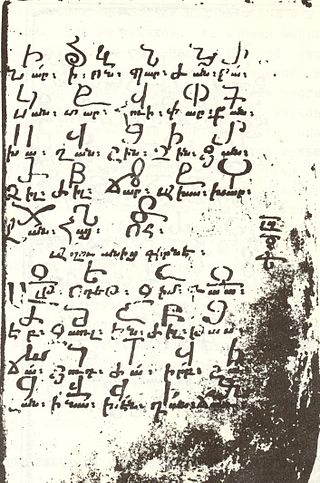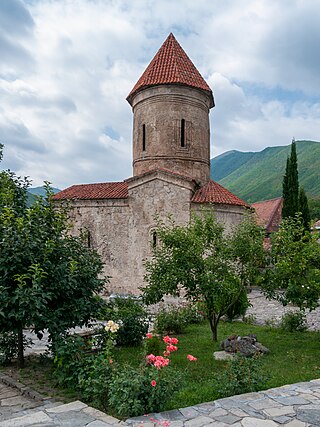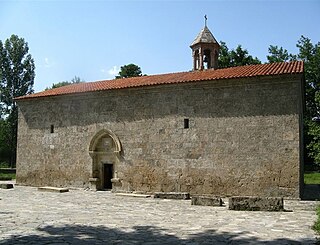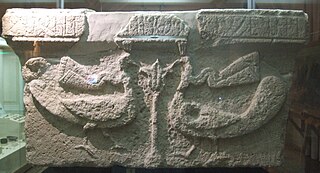
Caucasian Albania is a modern exonym for a former state located in ancient times in the Caucasus, mostly in what is now Azerbaijan. The modern endonyms for the area are Aghwank and Aluank, among the Udi people, who regard themselves as descended from the inhabitants of Caucasian Albania. However, its original endonym is unknown.

Arran, also known as Aran, was a geographical name used in ancient and medieval times to signify a historically-Iranian region which lay within the triangle of land, lowland in the east and mountainous in the west, formed by the junction of the Kura and Aras rivers, including the highland and lowland Karabakh, Mil plain and parts of the Mughan plain. In pre-Islamic times, it corresponded roughly to the territory of the modern-day Republic of Azerbaijan. The term is the Middle Persian equivalent to the Greco-Roman Albania. It was known as Aghvania, Alvan-k in Armenian, and Al-ran in Arabic.
The Udi language, spoken by the Udi people, is a member of the Lezgic branch of the Northeast Caucasian language family. It is believed an earlier form of it was the main language of Caucasian Albania, which stretched from south Dagestan to current day Azerbaijan. The Old Udi language is also called the Caucasian Albanian language and possibly corresponds to the "Gargarian" language identified by medieval Armenian historians. Modern Udi is known simply as Udi.

Amaras Monastery is an Armenian monastery near the village of Sos, de facto in the Martuni Province of the Republic of Artsakh, de jure in the Khojavend District of Azerbaijan, in the disputed region of Nagorno-Karabakh. It was a prominent religious and educational center in medieval Armenia.

Utik was a historic province of the Kingdom of Armenia. It was ceded to Caucasian Albania following the partition of Armenia between Sassanid Persia and the Eastern Roman Empire in 387 AD. Most of the region is located within present-day Azerbaijan immediately west of the Kura River, while a part of it lies within the Tavush province of present-day northeastern Armenia.

Christianity in Azerbaijan is a minority religion. Christians who estimated between 280,000 and 450,000 (3.1%–4.8%) are mostly Russian and Georgian Orthodox and Armenian Apostolic. There is also a small Protestant Christian community which mostly came from Muslim backgrounds.

The Caucasian Albanian script was an alphabetic writing system used by the Caucasian Albanians, one of the ancient Northeast Caucasian peoples whose territory comprised parts of the present-day Republic of Azerbaijan and Dagestan.

The Church of Kish, also known from different sources as Church of Saint Elishe or Holy Mother of God Church, is a Georgian Orthodox church, probably dating to the early 12th century, inactive due to lack of parishioners since the 19th century, although -as of 2000- mass was still regularly held by a Georgian priest. It is located in the village of Kiş approximately 5 km north of Shaki, Azerbaijan. Archaeological research undertaken in 2000 concluded that it was first built as a diophysite Georgian church, later to become a Chalcedonian church. Previous research had proposed that it had functioned at different times as a Caucasian Albanian Apostolic church, a Chalcedonian church within the Georgian Orthodox Church, and later as an Armenian Apostolic Church.
The population of Armenia includes various significant minority ethnic groups.

Nij is a town in the Qabala District of Azerbaijan, located forty kilometers south-west of Qabala. It's one of the world's few settlements of Udi people. It has a population of 5,744.

Kiş is a village and municipality in the Shaki Rayon of Azerbaijan. It is located approximately 5 km north of Shaki. It has a population of 6,244.
The Church of Albania or the Albanian Apostolic Church was an ancient, briefly autocephalous church established in the 5th century. In 705, It fell under the religious jurisdiction of the Armenian Apostolic Church as the Catholicosate of Aghvank centered in Caucasian Albania, a region spanning present-day northern Azerbaijan and southern Dagestan.

Voroshil Levonovich Gukasyan (1932–1986) was a Soviet linguist, caucasologist and specialist in Udi language and Caucasian Albanian inscriptions. He was born in the village Nij, Azerbaijan and was Udi by ethnicity.

Caucasian Albanian is an extinct member of the Northeast Caucasian languages. It was spoken in Caucasian Albania, which stretched from current day south Dagestan to Azerbaijan. Linguists believe it is an early linguistic predecessor to the endangered North Caucasian Udi language. The distinct Caucasian Albanian alphabet used 52 letters.

Saint Elisæus, Ełišay, Yeghishe or Ełišē was the first patriarch of the Church of Caucasian Albania by local tradition.

Zinobi Silikashvili was a Georgian public figure of Udi origin, the first leader of the Georgian Udi community and founder of Zinobiani village in Qvareli Municipality of Georgia.

Zinobiani, formerly Oktomberi is a village in Georgia. It is located in eastern Georgia, in the Qvareli Municipality of the Kakheti region. It has been one of the main places of compact residence of the Udis since 1920s.

Church of Saint Elisæus — was a former Eastern Orthodox church and Armenian Apostolic Church named after Elisaeus of Albania; now a museum located in Oğuz, Azerbaijan.
Eghiazar was the Catholicos and head of Caucasian Albanian Church in the late 7th century.


















